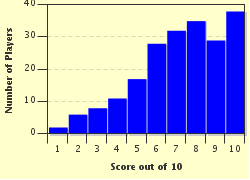Quiz Answer Key and Fun Facts
1. This renowned writer penned 154 sonnets and compiled them in one collection rather humbly entitled "Sonnets". Who is this individual whose famous fourteen-lined poems begin with such lines as "My mistress' eyes are nothing like the sun" and "Shall I compare thee to a summer's day"?
2. To say this individual forever altered her nation, and Western society at large, would indeed be an understatement. Her reach also extended into the realm of literature. Who was this author of quite a few poems, including "On Monsieur's Departure" about her grief, which she keeps hidden for political reasons, after the end of a relationship with a man for whom she apparently cared deeply?
3. Long before he was beheaded for treason against the state of England, Sir Thomas More published a fictional and philosophical book in 1516 about the deterioration and corruption of contemporary European society contrasted against an alternative successful and enviable society on an island somewhere in the New World (the Americas). What is the title of this book, named for the mysterious island itself?
4. What English diplomat and statesman, who spent time in the Tower of London because of accusations of adultery with Anne Boleyn and later because of charges of treason, introduced the sonnet as a form of poetry to the English, and is known for his translations of Petrarch's sonnets, such as the one that begins "Whoso list to hunt, I know where is an hind"?
5. What was the name of the English law student, doctor, composer, and poet who lived from 1567 to 1620 and not only wrote traditional English lyrics such as "When to her lute Corinna sings", but also experimented with quantitative verse (based on the length of time required to pronounce the syllables) in such poems as "Rose-cheeked Laura"?
6. One of this writer's best known poems is his reply to Christopher Marlowe's "The Passionate Shepherd to His Love" called "The Nymph's Reply to the Shepherd". He also left an ambitious yet incomplete book entitled "The History of the World". Who was this Renaissance man who was a soldier, courtier, philosopher, scientist, and explorer who also led England's first attempt to colonize the New World at Roanoke?
7. What is the title of the six-book allegorical masterpiece written by Edmund Spenser that is a combination of epic and romance poetry, and which begins with a tale of the Red Crosse Knight who travels through the wilderness with a beautiful and chaste young woman while on his way to do battle with Errour, a giant half-woman, half-serpent beast?
8. What was the title of the sonnet sequence, or collection of related sonnets, written by Sir Philip Sidney about two star-crossed lovers--the male, who is fated to pursue the female because of the significance of their names, and the female, who aloofly resists the male's advances and often ignores him?
9. Which famous play by Christopher Marlowe, both because of a significant pact between the main character and Satan and because of its scenes filled with devils and necromancy, created as much of a sensation among London's audiences in the 16th century as the release of the movie "The Exorcist" created in the United States in the 20th century?
10. While over thirty-five plays are credited to William Shakespeare, most people are familiar with only his tragedies and maybe a few of his comedies as well. However, how many of his histories do you know? Which of the following is NOT the title of a history play written by Shakespeare?
Source: Author
alaspooryoric
This quiz was reviewed by FunTrivia editor
looney_tunes before going online.
Any errors found in FunTrivia content are routinely corrected through our feedback system.

